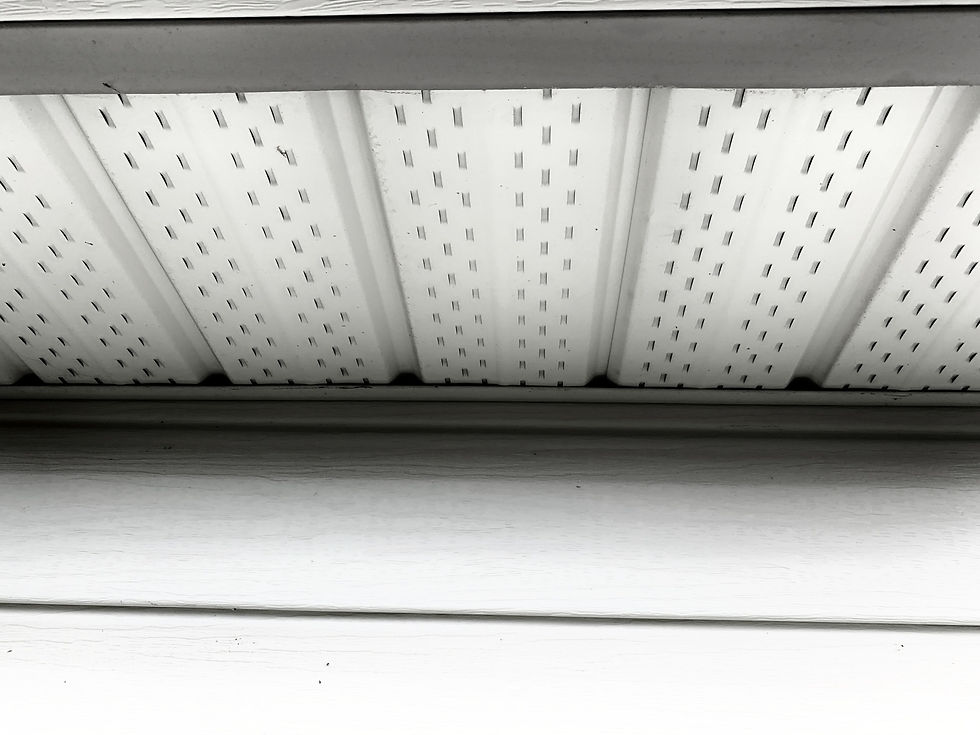All About Roof Ventilation
- Frontline Team

- Dec 2, 2019
- 3 min read
Updated: Mar 30, 2022
Quick fact: this is especially important as it pertains to ice damming. Roof ventilation is the key to solving the ice damming problem as we heat our homes during winter months. If you're unfamiliar with ice damming, learn more here. Not all roofs are the same. This article will discuss the 'best-case scenario' configuration to achieve adequate ventilation, which will prevent many common issues from occurring.
A few key facts to be aware of:
All roof systems require air intake (such as soffits) and exhaust (such as roof exhaust vents) for the purposes of ventilation. When the intake and exhaust are working together, your roof system can breathe and achieve balance with outside conditions (humidity and temperature).
All roof system ventilation occurs above the insulation layer and outside of the thermal envelope of the home.

Most residential roof substructures can be categorized into two major types:
Attics
Cathedral/Sloped Ceilings
Attics
As most will be familiar with, an attic is the space above an insulated ceiling and below the roof deck. This space is unheated and separate from the living space. A well-ventilated attic space will be as close to outside temperature as possible. By ensuring adequate ventilation, many problematic issues will be mitigated or solved completely. Poorly ventilated attics will experience:
condensation issues
mold on wood surfaces
dry rot of wood structure
snow melt in winter months and ice damming
leaks arising from condensation or ice dam thaw
Attic space ventilation is achieved by allowing warmer air to escape through roof exhaust vents (pictured below: 3-tier attic exhaust vent), which induces a negative pressure or suction in the attic space near the eaves and draws in cooler outside air from the soffits (soffits act as an intake). As roofs vary in size, so do ventilation requirements. A larger attic space will need more exhaust vents and more intake when compared to a smaller one. If your attic is significantly warmer than outside temperature, that is an obvious symptom of poor ventilation.
Cathedrals
Cathedrals (or sloped ceilings) are notoriously the most challenging and problematic to properly ventilate. This is mostly due to the limited space we have to work with. By comparison, an attic will usually have at least 2-4ft of open space above the insulation whereas a cathedral will often have an inch or two between framing members. Since there's little to no space above the insulation layer, air flow is restricted. It can often times be a costly endeavour to ensure there is good continuous air flow from your soffit to your roof exhausts since accessing this area can only be done by removing ceilings inside or removing the roof deck from above.
To ventilate a cathedral, typical attic exhaust vents will not work as we must ensure that air is moving between all rafters. So, instead, ridge venting is used, which typically sits only a few inches high and is installed along the length of the ridge (peak). It is intended to be a continuous exhaust from one end to the other. Unfortunately, ridge venting suffers from being easily blocked by snow because of its low profile. In this case, a good alternative is a continuous duct system with large tiered exhaust vents to ensure the entirety of any cathedral exhaust is functioning all year (pictured below).
These duct systems must be custom-made and are more costly, but they provide for us a solution where there wasn't one before.
Ventilating a cathedral roof is a relatively straight-forward process for standard dwellings, however, one older home design continues to plague us in the roofing industry. That is, the 'storey and a half' home. If this is you, be it known that no matter the roof type or style of construction, there is a solution. We'll address the 'storey and a half' home design issues in a future article!
We hope this information was helpful - contact us if you'd like to discuss your unique situation.
Related Article: Ice Damming 101





Comments